Knead into your knowledge the multifaceted symbolism of locusts in the Bible and discover ancient wisdom for today's world.
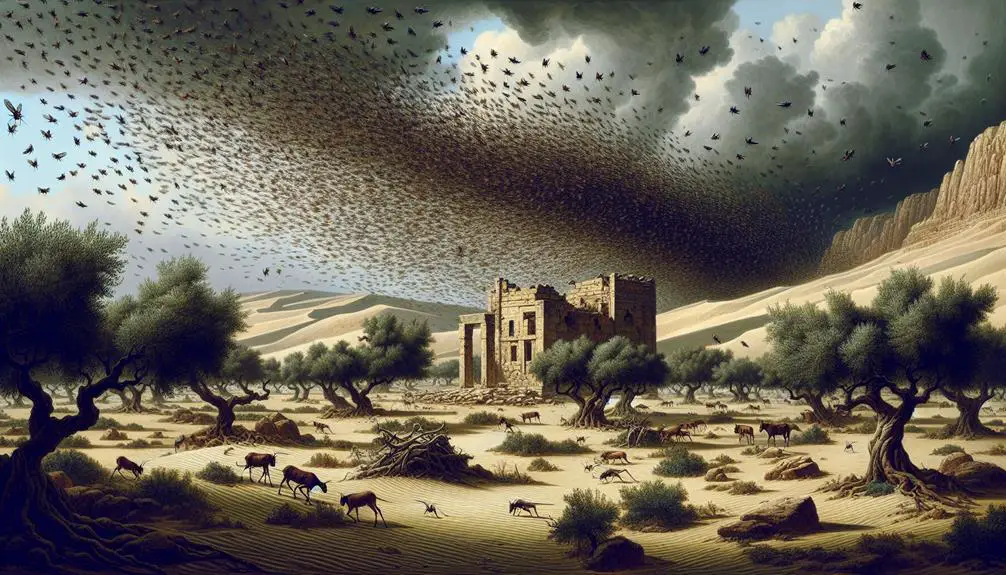
Images of Locusts in the Bible
Did you know locusts are mentioned more than 20 times in the Bible? They're depicted in various roles, from agents of plague in Exodus to symbols of destruction in the Book of Joel.
As you explore these biblical passages, you'll uncover the deep symbolism and interpretations that locusts carry, reflecting on everything from divine retribution to prophetic visions.
However, what's truly fascinating is how these ancient texts might still speak to our modern world. Let's embark on a journey to uncover the layers of meaning behind these images, and consider what lessons they might hold for us today.
Key Takeaways
- Locusts in the Bible symbolize divine judgment, emphasizing the consequences of straying from spiritual paths.
- Biblical locust plagues illustrate the sudden and devastating impact of natural disasters on human prosperity and agriculture.
- Through locust imagery, the Bible teaches lessons on resilience, environmental stewardship, and the importance of adaptability in the face of challenges.
- Locust metaphors in scripture reflect on human vulnerability, urging reflection on repentance, sustainability, and the impermanence of wealth.
The Plague of Locusts in Exodus
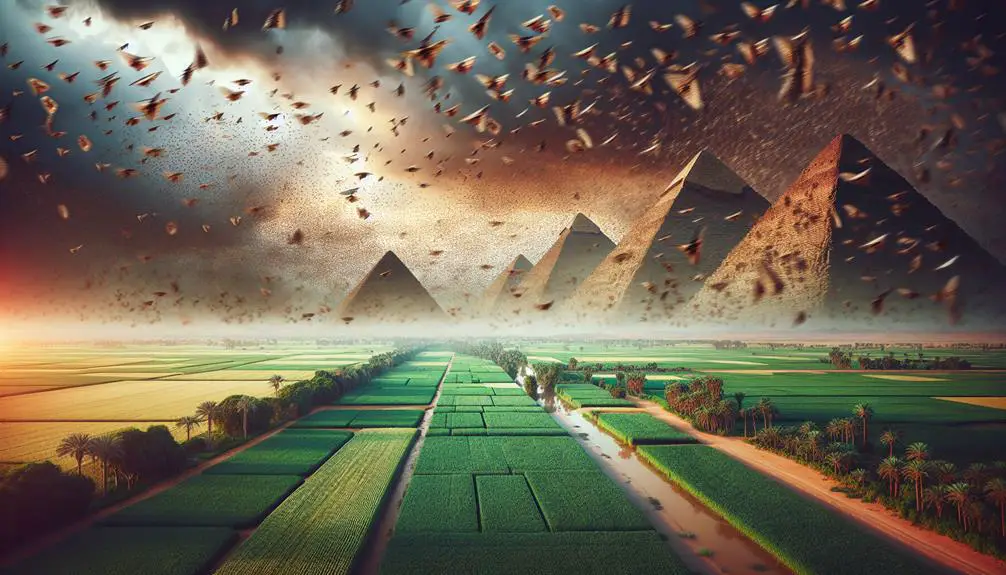
In the book of Exodus, the plague of locusts emerges as a pivotal event, where God unleashes this calamity upon Egypt as a means to compel Pharaoh to release the Israelites from bondage. This narrative, while deeply theological, also provides insight into the agricultural impacts of locust invasions in ancient times. You'll find that locusts, as depicted in Exodus, weren't merely a symbol of divine wrath but a real threat to the sustenance and economy of ancient societies.
The description of the locusts devouring everything in their path underscores the vulnerability of agrarian economies to such pests. The agricultural impacts were devastating, with crops, and thus food supplies, being decimated. This scenario invites you to consider the ancient methods of pest control. While the text doesn't detail specific strategies used to combat the locusts, it's known that ancient societies often relied on manual methods, such as hand-picking or using simple tools to remove or kill locusts.
These efforts, however, would have been largely ineffective against a plague of biblical proportions, highlighting the limited pest control options available in ancient times and the consequent severe vulnerability of agricultural production.
Locusts in the Book of Joel

You'll find that the Book of Joel employs locust plague imagery not merely as a historical recount but as a multifaceted symbol.
It intricately weaves the devastation caused by locusts with prophetic meanings, urging a deeper understanding of divine messages.
This analysis leads to the exploration of themes surrounding repentance and the promise of restoration, revealing the layered complexity of these biblical narratives.
Joel's Locust Plague Imagery
One can't overlook the profound impact of locust plague imagery in the book of Joel, which serves as a vivid metaphor for divine judgment and societal collapse.
This imagery not only captures the immediate agricultural impact, devastating crops and threatening famine, but also reflects broader cultural perceptions of disaster and divine retribution.
The locusts, described in apocalyptic terms, serve as a powerful symbol of an unstoppable force of nature, laying bare the vulnerabilities of human societies.
Joel's vivid descriptions underscore the fragility of agricultural systems that were central to the community's survival and prosperity.
Prophetic Meanings Unveiled
Building on the vivid imagery of locust plagues in Joel, it's essential to explore the layered prophetic meanings these events encapsulate, revealing insights into divine judgment and the potential for redemption.
Locust metaphors in the biblical text aren't merely descriptive but serve as a powerful symbol of the overwhelming and devastating impact of God's judgment on societal sin and disobedience. Historical infestations of locusts, which ravaged lands and livelihoods, provide a tangible context for understanding the severity of the divine warning conveyed through Joel.
The prophet's use of locust imagery is thus intricately linked with the historical reality of his audience, making the threat of divine judgment palpably real and imminent. Through this lens, Joel's message transcends its historical context, offering timeless insights into the nature of divine justice and human responsibility.
Repentance and Restoration
In the Book of Joel, the narrative often shifts focus to emphasize the potential for repentance and restoration following the devastation wrought by locust plagues.
This biblical account intricately links the physical destruction of locust invasions with a call for personal transformation and communal penitence. It suggests that the calamities serve not merely as punishment but as catalysts for spiritual renewal.
Joel's prophetic message underscores the idea that sincere repentance can lead to profound restoration, both materially and spiritually. The text delves into the concept that collective acknowledgment of wrongdoing and turning back to divine precepts can trigger divine mercy and abundance.
Thus, the locusts, beyond their immediate terror, symbolize a profound opportunity for societal and individual rebirth.
John the Baptist and Locusts

You'll find John the Baptist's choice of locusts for his diet in the wilderness not merely a matter of sustenance but deeply symbolic.
This dietary detail underscores a profound connection to humility, asceticism, and possibly a prophetic alignment with Old Testament themes.
Analyzing the significance, symbolism, and interpretation of this choice offers insights into the broader narrative contexts and theological implications within Biblical literature.
Locust Diet Significance
Regarding the Biblical account, John the Baptist's choice to consume locusts and wild honey holds profound symbolic and practical implications, reflecting his ascetic lifestyle and the rich metaphorical landscape of the Scriptures. This diet not only underscores his commitment to simplicity and detachment from worldly pleasures but also situates him within the broader context of locust swarms' agricultural impacts.
Historically, locust swarms have been a significant threat to food security, devouring crops and leading to famine. Thus, by eating locusts, John symbolically turns a force of destruction into sustenance, highlighting a theme of redemption. His diet, steeped in the hardships and realities of his time, offers a tangible connection to the natural world and its cycles of devastation and renewal.
Symbolism and Interpretation
Delving into the symbolism of John the Baptist's diet, one finds that the consumption of locusts transcends mere sustenance, embodying a rich tapestry of metaphorical meanings within the Biblical narrative. Locusts, often seen as agents of agricultural destruction, carry profound metaphors for both desolation and renewal. John's choice reflects an embrace of simplicity and a prophetic call to repentance, paralleling the locusts' dual role in devastation and the heralding of new beginnings.
Aspect |
Significance |
|---|---|
Locust Metaphors |
Symbolize transformative change, judgment, and renewal. |
Agricultural Impacts |
Serve as a reminder of human vulnerability and ecological balance. |
This layered interpretation highlights John's role as a forerunner to Christ, signifying a spiritual harvest amidst the desolation, urging a return to faith and moral rectitude.
Prophetic Vision in Revelation

In the prophetic vision presented in Revelation, locusts symbolize an impending divine judgment, serving as a vivid metaphor for the consequences of human actions. This apocalyptic symbolism, deeply embedded within the narrative, underscores the severity of the End Time warnings. The text intricately connects the locusts' emergence to a broader eschatological framework, where they aren't merely pests but divine instruments of punishment.
Through a detailed examination of the locusts' characteristics and their ordained mission, one discerns a multilayered message about divine retribution and human agency. These locusts, unlike any earthly counterpart, are depicted with features that heighten their terrifying aspect, further emphasizing the seriousness of the divine warning. Their role in Revelation isn't to bring about destruction indiscriminately but to target those who've turned away from divine precepts, highlighting a selective judgment that respects the bounds of righteousness.
The narrative's use of locusts as symbols of divine wrath invites readers to reflect on the consequences of their actions and the importance of adherence to spiritual principles. This segment of Revelation, rich with apocalyptic symbolism and End Time warnings, serves as a poignant reminder of the potential outcomes of human disobedience and the profound nature of divine justice.
Symbolism and Interpretations

Exploring the symbolism and interpretations of locusts in biblical texts reveals layers of meaning that resonate with themes of judgment, transformation, and redemption. These creatures, often seen in swarms, aren't merely historical pests but embody profound metaphors for destruction and renewal within the scriptural narrative. Their presence in the Bible serves as a vivid illustration of divine intervention, whether as a form of punishment or a catalyst for change.
- Locust metaphors are richly embedded in biblical literature, symbolizing both the vulnerability of human endeavors to divine will and the potential for moral and spiritual renewal.
- The agricultural impacts of locusts, described in several passages, aren't merely historical accounts but are employed to underscore the fragility of human prosperity in the face of divine judgment.
- Through locust imagery, biblical texts weave complex narratives that challenge readers to reflect on themes of repentance, resilience, and the ultimate sovereignty of the divine.
- The interpretative journey through locust symbolism in the Bible invites a deeper understanding of how these ancient texts address universal human concerns about justice, redemption, and the natural world.
In dissecting these layers, one appreciates the nuanced approach biblical authors took to convey messages of hope and caution through the natural world.
Lessons for Modern Readers
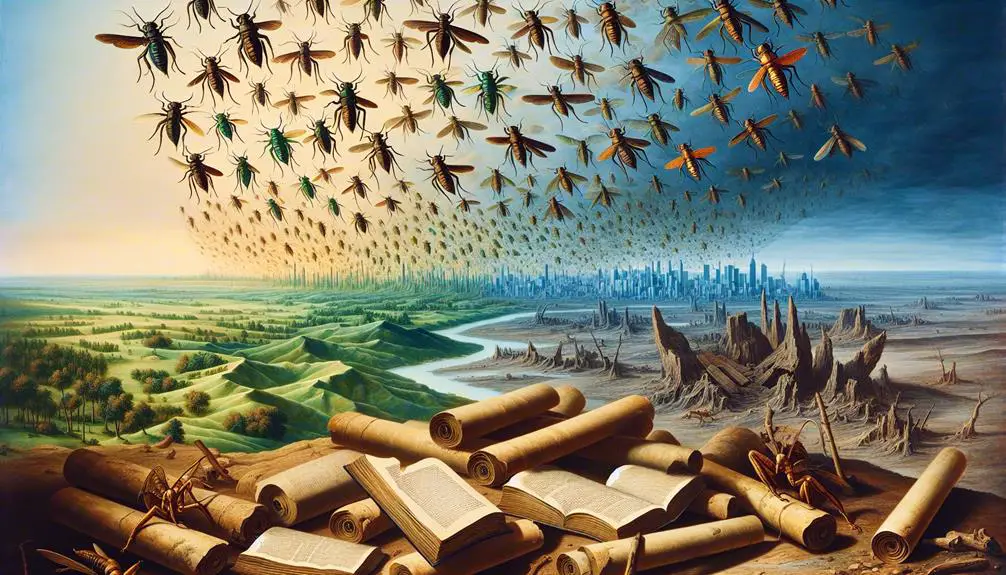
Reflecting on locust symbolism within biblical texts offers modern readers valuable insights into dealing with crises and understanding the impermanence of material wealth. The frequent biblical depictions of locust plagues underscore the profound agricultural impact these insects have, serving as a metaphor for sudden, devastating loss that can strip away prosperity in a blink. This narrative invites you to consider the vulnerability of human endeavors and the importance of resilience.
Furthermore, the locusts' ability for environmental adaptation, as highlighted in these ancient texts, speaks to the necessity of flexibility and innovation in the face of challenges. Just as locusts adjust to their surroundings to thrive, you're encouraged to develop adaptive strategies that ensure sustainability and mitigate the effects of unpredictable disasters. This perspective urges a reevaluation of how you interact with the environment, promoting a harmonious existence that can withstand the tests of time.
In essence, the biblical stories of locusts aren't just historical accounts of agricultural devastation but are rich with lessons on the impermanence of wealth, the inevitability of change, and the critical need for environmental stewardship. They call for a proactive, mindful approach to life's uncertainties, advocating for resilience, adaptability, and a deep respect for the natural world.
Frequently Asked Questions
How Have Cultural Perceptions of Locusts Outside the Bible Influenced Their Portrayal Within It?
You're exploring how cultural perceptions of locusts have shaped their biblical portrayal. Ancient symbolism often casts locusts as harbingers of doom, influencing their negative depiction in scripture.
Modern interpretations, however, delve into their role within ecological and symbolic contexts, sometimes offering a more nuanced understanding. This shift reflects broader changes in how we interpret texts and understand the natural world, emphasizing the dynamic relationship between cultural perceptions and biblical narratives.
Are There Any Historical Records or Archaeological Findings That Corroborate the Biblical Events Involving Locusts?
You're diving into a sea of history, seeking evidence of biblical locust plagues. While archaeological findings specifically validating these events are scarce, historical records from ancient civilizations often mention locust invasions, mirroring biblical accounts.
These records, coupled with modern comparisons of locust outbreaks, offer a scholarly perspective, suggesting a historical basis for these narratives. Analyzing these connections helps bridge the gap between ancient texts and the reality of locust impacts throughout history.
How Do Different Bible Translations Vary in Their Depiction of Locust-Related Events?
Different Bible translations vary in their depiction of locust-related events due to translation methodology and linguistic evolution.
You'll find that scholars meticulously analyze ancient texts, considering cultural and historical contexts to ensure accuracy.
As languages evolve, so do interpretations, leading to nuanced differences across versions.
This scholarly approach ensures that modern readers grasp the significance of these events, despite the challenges posed by linguistic shifts over centuries.
What Role Do Locusts Play in the Dietary Laws Outlined in the Bible, and How Has This Been Interpreted Over Time?
In the biblical dietary laws, locusts emerge as an intriguing exception to the prohibition of insects, allowing for their consumption. Over time, interpretations have varied, but locust recipes have found their place in certain traditions, reflecting a blend of historical and modern consumption practices.
Analyzing these shifts offers insight into the evolving relationship between religious texts and dietary habits, illustrating how ancient guidelines adapt to contemporary cultural and environmental contexts.
How Have Artists and Illustrators Historically Represented Biblical Locusts, and What Impact Has This Had on Public Perception?
Artists and illustrators have historically portrayed biblical locusts with a mix of awe and dread, deeply influencing public perception. This visual representation, rich in locust symbolism, bridges ancient scriptural descriptions and modern interpretations.
Through art, you see how these interpretations evolve, reflecting societal and theological shifts. The imagery not only conveys the historical and spiritual significance of locusts but also shapes how you understand their role within a broader biblical narrative.
Conclusion
You might argue that ancient texts bear little relevance today, yet the symbolism of locusts in the Bible transcends time, offering profound insights into human nature and divine judgment.
From the plagues of Egypt to the prophetic visions in Revelation, locusts embody both literal and metaphorical devastation. This intricate interplay invites you to ponder deeper truths about resilience, repentance, and renewal.
Engaging with these biblical images isn't just an academic exercise—it's a journey into understanding enduring human themes.

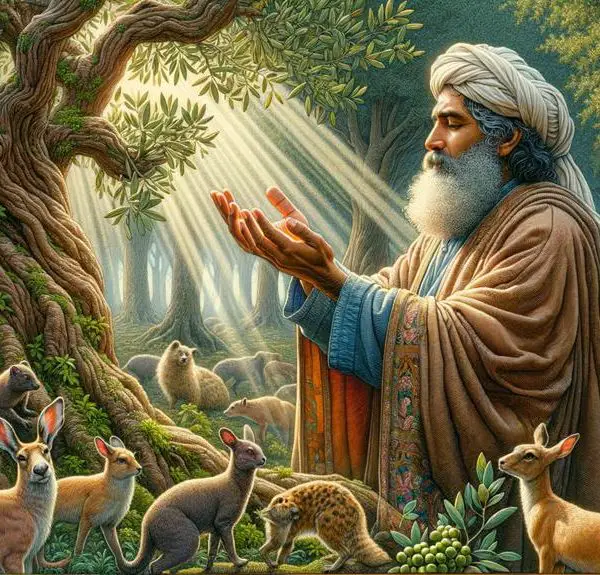
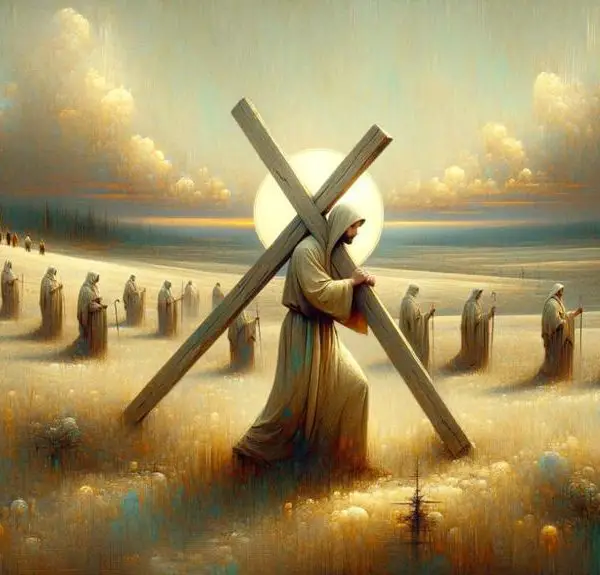
Sign up